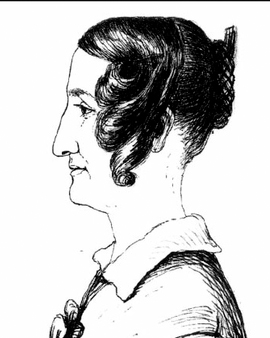Miss Drake, or Sarah Anne Drake, was a botanical artist and illustrator. She was born in 1803 in Skeleton, Norfolk, in the United Kingdom, and was a childhood friend of Anne Lindley, wife of the botanist John Lindley. In 1830 Miss Drake moved into the Lindleys' house in London and lived with the family until 1847. It is not clear in what capacity she was brought into the household (possibly as governess to the children), but her talent was soon recognized by Lindley, who set her to work as an illustrator of plant specimens. Soon after she moved into the household, then, Lindley began training Miss Drake. Miss Drake was called "Ducky" in the family and gradually developed into a very talented botanical artist. She became very accomplished and illustrated many of the pictures in Lindley's publications and also in other works such as Edwards' Botanical Register. In 1840 Lindley named the genus Drakaea in her honour when he described the specimens collected by James Drummond in the Swan River Colony as a single species, Drakaea elastica.
Although Miss Drake was a gifted orchid illustrator, Drake's illustrations were by no means only of orchids, she also created numerous other plant images, but it could be said that she excelled with orchids. Drake was prolific in her relatively short career, providing plates for Ladies Botany (1834-1837) and The Botanical Register (1815-1847), among others - for the latter she produced an astonishing 1,100 plates.
Miss Drake's best-known collaboration was with Augusta Innes Withers on the drawings for the monumental work Orchidaceae of Mexico and Guatemala by James Bateman. Immediately afterwards, when Drake's career ended because the Botanical Register had to close its doors in London in 1847, she returned to Norfolk to look after elderly relatives and moved in with her uncle Daniel Drake. In 1852 she married John Sutton Hastings, a wealthy farmer. The sensitive and caring Miss Drake died less than five years later on July 9, 1857, reportedly from diabetes, but it has been speculated that she may have suffered from cumulative poisoning from her paints. It was not until 2000 that a plaque commemorating her was placed on the parish church in whose graveyard she is now buried.
×





.jpg)
.jpg)
 - (MeisterDrucke-651741).jpg)
 - (MeisterDrucke-651741).jpg)
.jpg)
.jpg)
.jpg)
.jpg)
 - (MeisterDrucke-651700).jpg)
 - (MeisterDrucke-651700).jpg)
 - (MeisterDrucke-652492).jpg)
 - (MeisterDrucke-652492).jpg)
 - (MeisterDrucke-651865).jpg)
 - (MeisterDrucke-651865).jpg)
.jpg)
.jpg)
 - (MeisterDrucke-654295).jpg)
 - (MeisterDrucke-654295).jpg)
 - (MeisterDrucke-652006).jpg)
 - (MeisterDrucke-652006).jpg)
 - (MeisterDrucke-651768).jpg)
 - (MeisterDrucke-651768).jpg)
.jpg)
.jpg)
.jpg)
.jpg)
.jpg)
.jpg)
.jpg)
.jpg)
.jpg)
.jpg)
.jpg)
.jpg)
.jpg)
.jpg)
.jpg)
.jpg)
.jpg)
.jpg)
.jpg)
.jpg)
.jpg)
.jpg)
 - (MeisterDrucke-653909).jpg)
 - (MeisterDrucke-653909).jpg)
.jpg)
.jpg)
 - (MeisterDrucke-651817).jpg)
 - (MeisterDrucke-651817).jpg)
 - (MeisterDrucke-651729).jpg)
 - (MeisterDrucke-651729).jpg)
.jpg)
.jpg)
.jpg)
.jpg)
.jpg)
.jpg)
.jpg)
.jpg)
.jpg)
.jpg)
 - (MeisterDrucke-653912).jpg)
 - (MeisterDrucke-653912).jpg)
.jpg)
.jpg)
 - (MeisterDrucke-651766).jpg)
 - (MeisterDrucke-651766).jpg)
 - (MeisterDrucke-651853).jpg)
 - (MeisterDrucke-651853).jpg)
.jpg)
.jpg)
.jpg)
.jpg)
.jpg)
.jpg)
.jpg)
.jpg)
.jpg)
.jpg)
.jpg)
.jpg)
.jpg)
.jpg)
.jpg)
.jpg)
 - (MeisterDrucke-651698).jpg)
 - (MeisterDrucke-651698).jpg)
 - (MeisterDrucke-654292).jpg)
 - (MeisterDrucke-654292).jpg)
 - (MeisterDrucke-651890).jpg)
 - (MeisterDrucke-651890).jpg)
 - (MeisterDrucke-651737).jpg)
 - (MeisterDrucke-651737).jpg)
.jpg)
.jpg)
.jpg)
.jpg)
.jpg)
.jpg)
.jpg)
.jpg)
.jpg)
.jpg)
 - (MeisterDrucke-651830).jpg)
 - (MeisterDrucke-651830).jpg)
.jpg)
.jpg)
 - (MeisterDrucke-651842).jpg)
 - (MeisterDrucke-651842).jpg)
 - (MeisterDrucke-652005).jpg)
 - (MeisterDrucke-652005).jpg)
 - (MeisterDrucke-651838).jpg)
 - (MeisterDrucke-651838).jpg)
.jpg)
.jpg)
 - (MeisterDrucke-651795).jpg)
 - (MeisterDrucke-651795).jpg)
 Sw (This drawin - (MeisterDrucke-652150).jpg)
 Sw (This drawin - (MeisterDrucke-652150).jpg)
 - (MeisterDrucke-654298).jpg)
 - (MeisterDrucke-654298).jpg)
.jpg)
.jpg)
 - (MeisterDrucke-651765).jpg)
 - (MeisterDrucke-651765).jpg)
 - (MeisterDrucke-651808).jpg)
 - (MeisterDrucke-651808).jpg)
.jpg)
.jpg)
.jpg)
.jpg)
.jpg)
.jpg)
 - (MeisterDrucke-651821).jpg)
 - (MeisterDrucke-651821).jpg)
.jpg)
.jpg)
 - (MeisterDrucke-651756).jpg)
 - (MeisterDrucke-651756).jpg)
.jpg)
.jpg)
.jpg)
.jpg)
 - (MeisterDrucke-651739).jpg)
 - (MeisterDrucke-651739).jpg)
 - (MeisterDrucke-607405).jpg)
 - (MeisterDrucke-607405).jpg)
.jpg)
.jpg)
 - (MeisterDrucke-651748).jpg)
 - (MeisterDrucke-651748).jpg)
 - (MeisterDrucke-651814).jpg)
 - (MeisterDrucke-651814).jpg)
 - (MeisterDrucke-651731).jpg)
 - (MeisterDrucke-651731).jpg)
 - (MeisterDrucke-651850).jpg)
 - (MeisterDrucke-651850).jpg)
 - (MeisterDrucke-654283).jpg)
 - (MeisterDrucke-654283).jpg)
.jpg)
.jpg)
 - (MeisterDrucke-651752).jpg)
 - (MeisterDrucke-651752).jpg)
.jpg)
.jpg)
 - (MeisterDrucke-651736).jpg)
 - (MeisterDrucke-651736).jpg)
 - (MeisterDrucke-651901).jpg)
 - (MeisterDrucke-651901).jpg)
 - (MeisterDrucke-651851).jpg)
 - (MeisterDrucke-651851).jpg)
.jpg)
.jpg)
.jpg)
.jpg)
 - (MeisterDrucke-652521).jpg)
 - (MeisterDrucke-652521).jpg)
.jpg)
.jpg)
 - (MeisterDrucke-652244).jpg)
 - (MeisterDrucke-652244).jpg)
.jpg)
.jpg)
.jpg)
.jpg)
 - (MeisterDrucke-651813).jpg)
 - (MeisterDrucke-651813).jpg)
.jpg)
.jpg)
.jpg)
.jpg)
 - (MeisterDrucke-609471).jpg)
 - (MeisterDrucke-609471).jpg)
 - (MeisterDrucke-651772).jpg)
 - (MeisterDrucke-651772).jpg)
.jpg)
.jpg)
.jpg)
.jpg)






